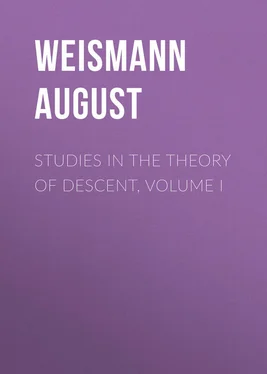August Weismann - Studies in the Theory of Descent, Volume I
Здесь есть возможность читать онлайн «August Weismann - Studies in the Theory of Descent, Volume I» — ознакомительный отрывок электронной книги совершенно бесплатно, а после прочтения отрывка купить полную версию. В некоторых случаях можно слушать аудио, скачать через торрент в формате fb2 и присутствует краткое содержание. Жанр: foreign_antique, foreign_prose, на английском языке. Описание произведения, (предисловие) а так же отзывы посетителей доступны на портале библиотеки ЛибКат.
- Название:Studies in the Theory of Descent, Volume I
- Автор:
- Жанр:
- Год:неизвестен
- ISBN:нет данных
- Рейтинг книги:4 / 5. Голосов: 1
-
Избранное:Добавить в избранное
- Отзывы:
-
Ваша оценка:
- 80
- 1
- 2
- 3
- 4
- 5
Studies in the Theory of Descent, Volume I: краткое содержание, описание и аннотация
Предлагаем к чтению аннотацию, описание, краткое содержание или предисловие (зависит от того, что написал сам автор книги «Studies in the Theory of Descent, Volume I»). Если вы не нашли необходимую информацию о книге — напишите в комментариях, мы постараемся отыскать её.
Studies in the Theory of Descent, Volume I — читать онлайн ознакомительный отрывок
Ниже представлен текст книги, разбитый по страницам. Система сохранения места последней прочитанной страницы, позволяет с удобством читать онлайн бесплатно книгу «Studies in the Theory of Descent, Volume I», без необходимости каждый раз заново искать на чём Вы остановились. Поставьте закладку, и сможете в любой момент перейти на страницу, на которой закончили чтение.
Интервал:
Закладка:
The peculiarity of this species consists in the fact that in all three summer generations only a portion of the pupæ emerge after a short period (fourteen days), whilst another and much smaller portion remains in the pupal state during the whole summer and succeeding winter, first emerging in the following spring, and then always in the winter form. Thus, Edwards states that out of fifty chrysalides of the second generation, which had pupated at the end of June, forty-five Marcellus butterflies appeared after fourteen days, whilst five pupæ emerged in April of the following year, and then as Telamonides .
The explanation of these facts is easily afforded by the foregoing theory. According to this, both the winter forms must be regarded as primary, and the Marcellus form as secondary. But this last is not yet so firmly established as Prorsa , in which reversion of the summer generations to the Levana form only occurs through special external influences; whilst in the case of Ajax some individuals are to be found in every generation, the tendency of which to revert is still so strong that even the greatest summer heat is unable to cause them to diverge from their original inherited direction of development, or to accelerate their emergence and compel them to assume the Marcellus form. It is here beyond a doubt that it is not different external influences, but internal causes only, which maintain the old hereditary tendency, for all the larvæ and pupæ of many different broods were simultaneously exposed to the same external influences. But, at the same time, it is evident that these facts are not opposed to the present theory; on the contrary, they confirm it, inasmuch as they are readily explained on the basis of the theory, but can scarcely otherwise be understood.
If it be asked what significance attaches to the duplication of the winter form, it may be answered that the species was already dimorphic at the time when it appeared in only one annual generation. Still, this explanation may be objected to, since a dimorphism of this kind is not at present known, though indeed some species exhibit a sexual dimorphism, 20in which one sex (as, for instance, the case of the female Papilio Turnus ) appears in two forms of colouring, but not a dimorphism, as is here the case, displayed by both sexes. 21Another suggestion, therefore, may perhaps be offered.
In A. Levana we saw that reversion occurred in very different degrees with different individuals, seldom attaining to the true Levana form, and generally only reaching the intermediate form known as Porima . Now it would, at all events, be astonishing if with P. Ajax the reversion were always complete, as it is precisely in this case that the tendency to individual reversion is so variable. I might, for this reason, suppose that one of the two winter forms, viz. the var. Walshii , is nothing else than an incomplete reversion-form, corresponding to Porima in the case of A. Levana . Then Telamonides only would be the original form of the butterfly, and this would agree with the fact that this variety appears later in the spring than Walshii . Experiments ought to be able to decide this. 22The pupæ of the first three generations placed upon ice should give, for the greater part, the form Telamonides , for the lesser portion Walshii , and for only a few, or perhaps no individuals, the form Marcellus . This prediction is based on the view that the tendency to revert is on the whole great; that even with the first summer generation, which was the longest exposed to the summer climate, a portion of the pupæ, without artificial means, always emerged as Telamonides , and another portion as Marcellus . The latter will perhaps now become Walshii by the application of cold.
One would expect that the second and third generations would revert more easily, and in a larger percentage, than the first, because this latter first acquired the new Marcellus form; but the present experiments furnish no safe conclusion on this point. Thus, of the first summer generation only seven out of sixty-seven pupæ hibernated, and these gave Telamonides ; while of the second generation forty out of seventy-six, and of the third generation twenty-nine out of forty-two pupæ hibernated. But to establish safer conclusions, a still larger number of experiments is necessary. According to the experience thus far gained, one might perhaps still be inclined to imagine that, with seasonal dimorphism, external influences operating on the individual might directly compel it to assume one or the other form. I long held this view myself, but it is, nevertheless, untenable. That cold does not produce the one kind of marking, and warmth the other, follows from the before-mentioned facts, viz. that in Papilio Ajax every generation produces both forms; and, further, in the case of A. Levana I have frequently reared the fourth (hibernating) generation entirely in a warm room, and yet I have always obtained the winter form. Still, one might be inclined not to make the temperature directly responsible, but rather the retardation or acceleration of development produced through the action of temperature. I confess that I for a long time believed that in this action I had found the true cause of seasonal dimorphism. Both with A. Levana and P. Napi the difference between the duration of the pupal period in the winter and summer forms is very great, lasting as a rule, in the summer generation of A. Levana , from seven to twelve days, and in the winter generation about two hundred days. In this last species the pupal state can certainly be shortened by keeping them at an elevated temperature; but I have, nevertheless, only in one case obtained two or three butterflies at the end of December from caterpillars that had pupated in September, these generally emerging in the course of February and March, and are to be seen on the wing in warm weather during the latter month. The greatest reduction of the pupal period still leaves for this stage more than 100 days.
From this last observation it follows that it is not the duration of development which, in individual cases, determines the form of the butterfly, and which consequently decides whether the winter or summer form shall emerge, but that, on the contrary, the duration of the pupal stage is dependent on the tendency which the forthcoming butterfly had taken in the chrysalis state. This can be well understood when we consider that the winter form must have had a long, and the summer form a short pupal period, during innumerable generations. In the former the habit of slow development must have been just as well established as that of rapid development in the latter; and we cannot be at all surprised if we do not see this habit abandoned by the winter form when the opportunity presents itself. But that it may be occasionally abandoned the more proves that the duration of the pupal development less determines the butterfly form than does the temperature directly, in individual cases.
Thus, for instance, Edwards explicitly states that, whereas the two winter forms of P. Ajax , viz. the vars. Walshii and Telamonides , generally appear only after a pupal period of 150 to 270 days, yet individual cases occur in which the pupal stage is no longer than in the summer form, viz. fourteen days. 23A similar thing occurs with A. Levana , for, as already explained, not only may the development of the winter form be forced to a certain degree by artificial warmth, but the summer generation frequently produces reversion-forms without protraction of development. The intermediate reversion-form Porima was known long before it was thought possible that it could be produced artificially by the action of cold; it appears occasionally, although very rarely, at midsummer in the natural state.
Читать дальшеИнтервал:
Закладка:
Похожие книги на «Studies in the Theory of Descent, Volume I»
Представляем Вашему вниманию похожие книги на «Studies in the Theory of Descent, Volume I» списком для выбора. Мы отобрали схожую по названию и смыслу литературу в надежде предоставить читателям больше вариантов отыскать новые, интересные, ещё непрочитанные произведения.
Обсуждение, отзывы о книге «Studies in the Theory of Descent, Volume I» и просто собственные мнения читателей. Оставьте ваши комментарии, напишите, что Вы думаете о произведении, его смысле или главных героях. Укажите что конкретно понравилось, а что нет, и почему Вы так считаете.












